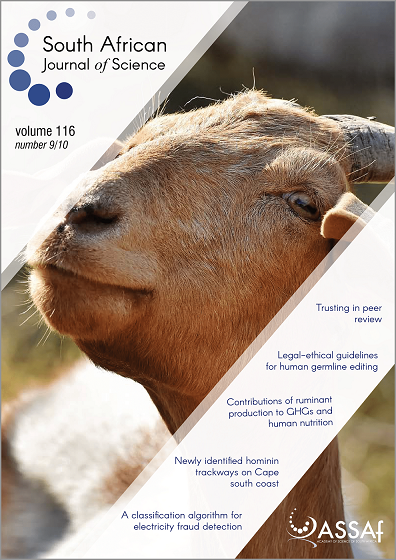Lantana camara invasion along road–river interchanges and roadsides in Soutpansberg, Vhembe Biosphere Reserve in South Africa
DOI:
https://doi.org/10.17159/sajs.2020/8302Keywords:
disturbance, invasive plant, management, road surveyAbstract
Roads and rivers act as conduits of alien plant invasion; however, little is known regarding the abundance and invasion extent of Lantana camara, an invasive shrub, along road–river interchanges and roadsides in South Africa. We assessed the effects of road–river interchanges and roadsides as invasion corridors that facilitate L. camara invasion. A road survey method was used to measure the invasion extent of L. camara along road–river interchanges and roadsides from national and regional roads covering 446 km in Soutpansberg, Vhembe Biosphere Reserve, South Africa. L. camara occurred along 21 of the 48 surveyed road–river interchanges and its abundance and cover were similar between road–river interchanges and roadsides, although height and diameter of L. camara were greater along road–river interchanges than roadsides. Other alien species that dominated road–river interchanges were Solanum mauritianum, Caesalpinia decapetala and Rubus rigidus. Our results indicate that L. camara dominates both road–river interchanges and roadsides, therefore roads and bridges should be considered important targets for L. camara control.
Significance:
- Despite the huge efforts by the South African government to control invasive alien plants, roads and rivers continue to act as important conduits for invasion and therefore there is a need to manage them.
- We propose that South African roads be considered important targets for efforts to control invasive alien plants.
- A policy and legislative framework around invasive alien plant removal during routine road maintenance operations is required.
Downloads
Published
Issue
Section
License

All articles are published under a Creative Commons Attribution 4.0 International Licence
Copyright is retained by the authors. Readers are welcome to reproduce, share and adapt the content without permission provided the source is attributed.
Disclaimer: The publisher and editors accept no responsibility for statements made by the authors
How to Cite
- Abstract 1337
- PDF 752
- EPUB 220
- XML 356
- Supplementary Material 201
Funding data
-
National Research Foundation
Grant numbers Thuthuka grant (TTK190117408656) -
Department of Science and Technology, Republic of South Africa
-
National Research Foundation












.png)